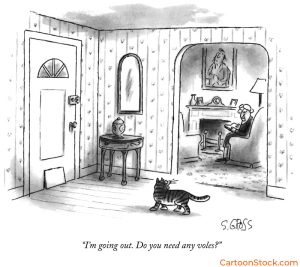
Cartoon critics Phil Witte and Rex Hesner look behind the gags to debate what makes a cartoon tick. This week our intrepid critics take a look at Gifts.
As the winter holidays loom, it’s not too early to think about gifts. Gift-giving can be a chore or a pleasure, but it’s a tradition that is firmly established in our culture—and firmly established traditions make great cartoon targets.
Given the time of year, it’s appropriate to begin with a few Christmas-themed cartoons. Liam Francis Walsh delivers with a caption-less cartoon featuring Russian nesting dolls. This quaint object of folk art has inspired a surprisingly large number of cartoons. Infinite regression apparently somehow resonates with cartoonists.
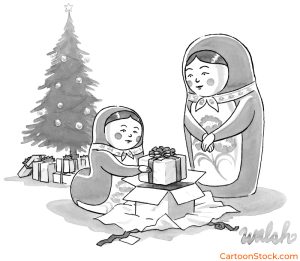
P.S. Mueller is known for his highly imaginative and singularly odd cartoons drawn in a simple, blocky style. It’s quite a feat to illustrate the joy of giving when the gift is a toaster and the recipient is a slice of bread.
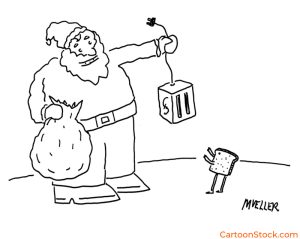
Barbara Smaller’s cartoons often focus on everyday relationships among family members and friends. Here she employs the well-known humor technique of having a child make an observation in the language of an adult.
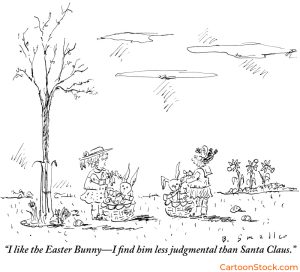
Of course, birthdays are the other yearly occasion for gift-giving and, with luck, receiving. Here’s another Barbara Smaller cartoon, this time with the birthday honoree celebrating the event with an armload of gifts. The humor derives from giving the surprise party a new context, one that the nonplussed husband had not considered.
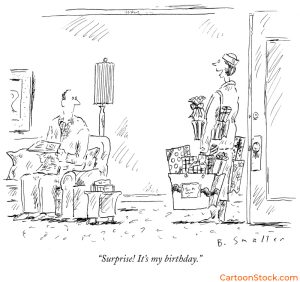
A snarkier version of celebrating oneself is this cartoon by Jack Ziegler. Once again, the husband is oblivious while the wife pours on the sarcasm. The wording of the caption is noteworthy in that the gag is complete with “I remembered?” but the added capper “Well, thank me very much!” brings it all home. It’s reminiscent of Bob Mankoff’s famous cartoon of the businessman on the phone repeating the gag line: “How about never—is never good for you?” Call it wiseguy humor.
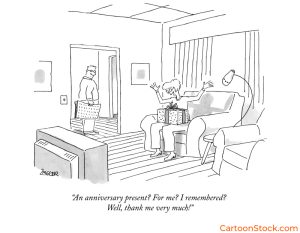
When an occasion calls for a gift, where to buy it requires thinking ahead. If one does not think ahead, one may end up in a shop like the one depicted in Bruce Eric Kaplan’s cartoon. The wife seems eager to pick up a tchotchke, despite the clear caveat emptor warning on the storefront window, while the husband appears skeptical. As with many of BEK’s cartoons, this one takes a cynical view of its subject.
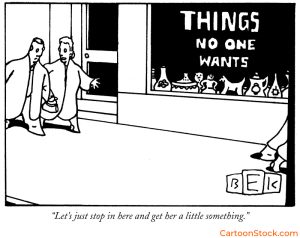
Museum gift shops have been a prime source of revenue, so much so that a stand-alone gift shop, sans museum, seems like a natural retail opportunity. It takes a cartooning wizard like Mick Stevens to imagine such a store.
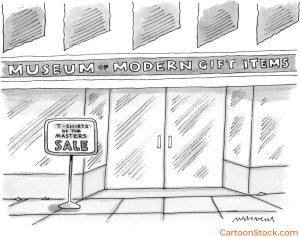
Art museums overflow with benefactor gifts. These veritable institutions acknowledge the donors’ generosity on a plaque, usually below the identification of the artwork and artist. In Leo Cullum’s caption-less cartoon, one suspects the donor had no problem parting with this object. At least the curator felt it was appropriate to put him on a pedestal.
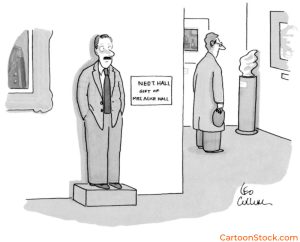
It’s fair to say that women are more attuned than men to the nuances of gift-giving. The sincerity of the man in Liana Finck’s cartoon may be questioned, but the recipient appears touched. This cartoon is a fine example of how the drawing and gag work together to produce a jolt of humor.
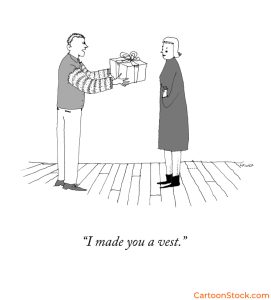
If husbands are not great at selecting gifts, wives are often not forthcoming with their preferences. Men in general need specific instructions on the art of the gift; otherwise, women end up with a situation similar to what Joe Dator has depicted. Those stylized monkeys are delightfully drawn, and the woman’s stoic response to the monkey’s exploration of her head is perfect. By the way, Joe has a new book out called Inked about his cartooning, plus a children’s Christmas book he illustrated, Santa Doesn’t Need Your Help.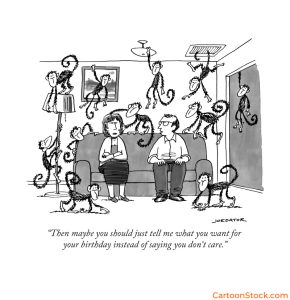
Bringing something to a friend’s party is tricky business. Your tastes may differ from your friend’s tastes, a fact you may not learn until you see your friend feign gratitude. William Heafeli’s cartoon features a couple who go through some mental gymnastics before offering their present. The caption just proves the adage that it’s the thought that counts.
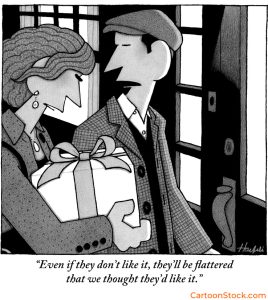
We conclude with a cartoon by veteran cartoonist Sam Gross. Cats are known to bring home little “gifts” in the form of small rodents and birds. This considerate feline checks in with its owner before prowling the neighborhood. Note the choice of the word “voles” over the more common prey of mice or moles. “Vole,” being unusual, heightens the humor.
